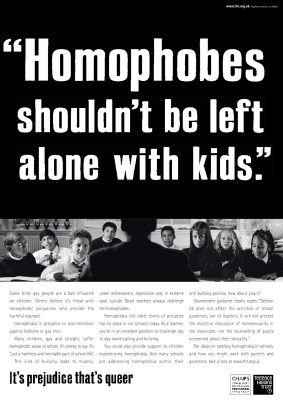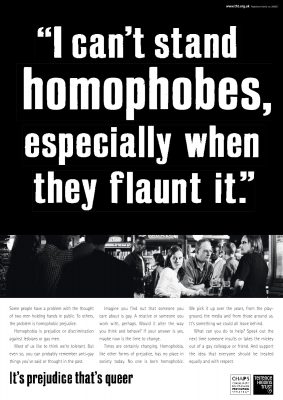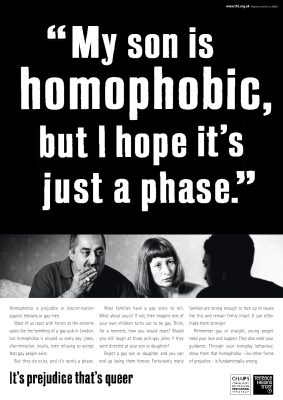This was a rare example of a THT 'gay and bisexual men' campaign that was designed to been seen by the general population.
One of the reasons that's rare is that advertising on, say, London Underground is considerably more expensive than in a scene magazine or given to workers to hand out at scene venues. (If you did actually want to reach as many gay and bisexual men in London as possible, places like the Underground and the Metro and Evening Standard newspapers is where you'd do it…)
The graphics here aren't particularly good quality, being in a low resolution even in the original PDF from tht.org.uk, despite being intended to be seen on A3 or larger posters.
This is particularly noticeable on the CHAPS logo, which is almost unreadable,[1]Whether someone simply made the mistake of exporting them in a low screen resolution rather than the print one, I don't know. Fortunately, the body text looks to be done properly and it was possible … Continue reading but it means that it was definitely part of a program to reduce HIV infection in gay and bisexual men that got about £1m of funding from the Department of Health every year.
It was recognised by Martin Kirk of the UK Gay Men's Health Network in giving evidence to the All-Party Parliamentary Group on AIDS as "an HIV campaign but it is a campaign targeted at prejudice against, in this case, gay men".
As we'll see, this was more correct than it should have been.
"Homophobes shouldn't be left alone with kids"

Some think gay people are a bad influence on children. Others believe it's those with homophobic prejudices who provide the harmful example.
Homophobia is prejudice or discrimination against lesbians or gay men.
Many children, gay and straight, suffer homophobic abuse at school. It's wrong to say it's "just a harmless and inevitable part of school life".
This kind of bullying leads to truancy, under achievement, depression and, in extreme case, suicide. Good teachers always challenge the homophobes.
Homophobia like other forms of prejudice has no place in our schools today. As a teacher, you're in an excellent position to challenge day to day name-calling and bullying.
You could also provide support to children experiencing homophobia. And many schools are addressing homophobia within their anti-bullying policies, how about yours?
Government guidance clearly states: "Section 28 does not affect the activities of school governors, nor of teachers. It will not prevent the objective discussion of homosexuality in the classroom, nor the counselling of pupils concerned about their sexuality."
For ideas on tackling homophobia in schools, and how you might work with parents and governors, take a look at www.tht.org.uk
This one was published in the Times Educational Supplement and the then weekly education section in the Guardian. The list of resources for teachers on the THT website did include Loraine Hutchins and Lani Ka'ahumanu's Bi Any Other Name – Bisexual People Speak Out, but it was the only bi resource and they misspelled Lani's surname as 'Kaahumany'.
"I can't stand homophobes, especially when they flaunt it"

Some people have a problem with the thought of two men holding hands in public. To others, the problem is homophobic prejudice.
Homophobia is prejudice or discrimination against lesbians or gay men.
Most of us like to think we're tolerant. But even so, you can probably remember anti-gay things you've said or thought in the past.
Imagine you find out that someone you care about is gay. A relative or someone you work with, perhaps. Would it alter the way you think and behave? If your answer is yes, maybe now is the time to change.
Times are certainly changing. Homophobia, like other forms of prejudice, has no place in society today. No one is born homophobic. We pick it up over the years, from the playground, the media and from those around us. It's something we could all leave behind.
What can you do to help? Speak out the next time someone insults or takes the mickey out of a gay colleague or friend. And support the idea that everyone should be treated equally and with respect.
This one was published in places like 'lads mag' Loaded and Cosmopolitan.
'My son is homophobic, but I hope it's just a phase'

Homophobia is prejudice or discrimination against lesbians or gay men.
Most of us react with horror at the extreme cases like the bombing of a gay pub in London, but homophobia is around us every day: jokes, discrimination, insults, even refusing to accept that gay people exist.
But they do exist, and it's rarely a phase.
Most families have a gay story to tell. What about yours? If not, then imagine one of your own children turns out to be gay. Think, for a moment, how you would react? Would you still laugh at those anti-gay jokes if they were directed at your son or daughter?
Reject a gay son or daughter and you can end up losing them forever. Fortunately many families are strong enough to face up to issues like this and remain firmly intact. It can often make them stronger.
Remember gay or straight, young people need your love and support. They also need your guidance. Through your everyday behaviour, show them that homophobia – like other forms of prejudice – is fundamentally wrong.
This one, targeted at parents, appeared in the News of the World, Family Circle, the Radio Times and on the London Underground.
Although THT were pleased enough with the campaign to repeat it in 2001, there's surprisingly little online about it. It would be fascinating to see what effect, if any, it had.
Overall:
Uses of 'gay' in the three posters: fifteen.
Uses of 'lesbian' in the three posters: three.
Uses of 'straight' in the three posters: two.
Uses of 'bisexual' / 'bi' in the three posters, part of a major project for "gay and bisexual men" remember: nil.
It's the third one that's the most outrageous example of bisexual erasure – which sexual orientation is most commonly dismissed as "a phase"?
Sadly, this was typical of most CHAPS materials.
Notes
| ↑1 | Whether someone simply made the mistake of exporting them in a low screen resolution rather than the print one, I don't know. Fortunately, the body text looks to be done properly and it was possible to copy and paste it. |
|---|